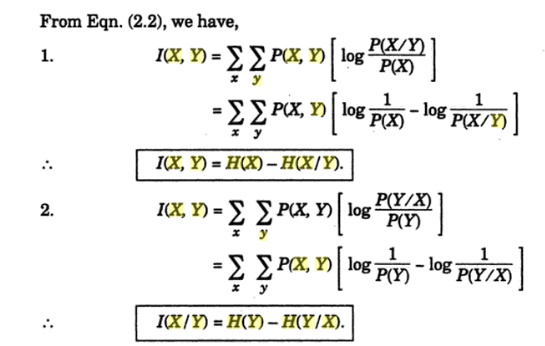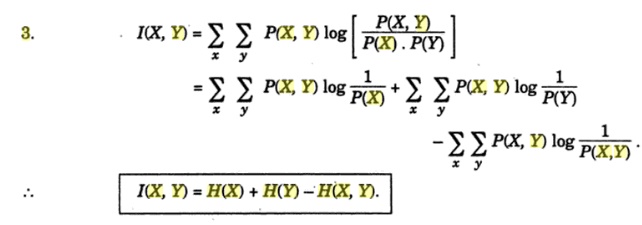Chapter: Analog and Digital Communication
Mutual Information
MUTUAL
INFORMATION
On
an average we require H(X) bits of information to specify
one input symbol. However, if we are allowed to observe the output symbol
produced by that input, we require, then, only H (X|Y)
bits of information to specify the input symbol. Accordingly, we come to the
conclusion, that on an average, observation of a single output provides with [H(X)
–H (X|Y)]

Notice
that in spite of the variations in the source probabilities, p (xk)
(may be due to noise in the channel), certain probabilistic information
regarding the state of the input is available, once the conditional probability
p (xk | yj) is computed at
the receiver end. The difference between the initial uncertainty of the source
symbol xk, i.e. log 1/p(xk)
and the final uncertainty about the same source symbol xk,
after receiving yj, i.e. log1/p(xk
|yj) is the information gained through the channel.
This difference we call as the mutual information between the symbols xk
and yj. Thus

This
is the definition with which we started our discussion on information theory.
Accordingly I (xk) is also referred to
as ‘Self Information‘.

Eq
(4.22) simply means that “the Mutual information ‟ is symmetrical with respect
to its arguments.i.e.
I (xk,
yj) = I (yj, xk)
Averaging
Eq. (4.21b) over all admissible characters xk
and yj, we obtain the average information gain of the
receiver:
I(X,
Y) = E {I (xk, yj)}



Or I(X, Y) = H(X)
+ H(Y) –H(X, Y)
Further, we conclude
that, ― even though for a particular received symbol, yj, H(X) –H(X | Yj) may
be negative, when all the admissible output symbols are covered, the average
mutual information is always non- negative‖. That is to say, we cannot loose information
on an average by observing the output of
a channel. An easy method, of remembering the various relationships, is given
in Fig 4.2.Althogh the diagram resembles a Venn-diagram, it is not, and the
diagram is only a tool to remember the relationships. That is all. You cannot
use this diagram for proving any result.
The
entropy of X is represented by the circle on the left and that of
Y by the circle on the right. The overlap between the two circles
(dark gray) is the mutual information so that the remaining (light gray)
portions of H(X) and H(Y) represent
respective equivocations. Thus we have
H(X
| Y) = H(X) –I(X, Y) and
H (Y| X) = H(Y) –I(X, Y)
The
joint entropy H(X,Y) is the sum of H(X)
and H(Y) except for the fact that the overlap is added
twice so that
H(X,
Y) = H(X) + H(Y) - I(X, Y)
Also observe H(X,
Y) = H(X) + H (Y|X)
= H(Y) + H(X
|Y)
For the JPM
given by I(X, Y) = 0.760751505 bits / sym
Related Topics